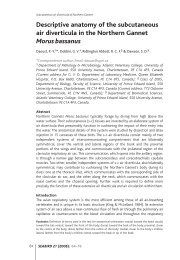Create successful ePaper yourself
Turn your PDF publications into a flip-book with our unique Google optimized e-Paper software.
184 T. DITTMANN ET AL. Atlantic <strong>Seabird</strong>s 3(4)<br />
Birds fledged<br />
100%<br />
75%<br />
50%<br />
25%<br />
0%<br />
1 ( 184) 2 (157) 3 (81)<br />
Hatching order<br />
<strong>No</strong> return<br />
Figure 2. Proportion of fledged Common Terns with known hatching order that were<br />
resighted in the natal colony (absolute numbers of returned and non-returned<br />
birds in brackets).<br />
Figuur 2. Percentage uitgevlogen jonge Visdieven met bekende volgorde van uitkomst<br />
dat na verloop van tijd terugkeerde als hoopvolle broedvogel in de kolonie<br />
(totale aantallen teruggekeerde en niet-teruggekeerde aantallen vogels).<br />
large tern species (Burger 1980). In the Common Terns studied, a higher<br />
number of fledged siblings did not result in increased mortality after fledging<br />
despite the possibility that competition for food might continue into the postfledging<br />
period. Viksne & Janaus (1993) even found greater survival of<br />
fledglings from large broods of Black-headed Gulls. Similarly, after fledging,<br />
hatching position of the Common Terns studied had no effect on survival. This<br />
is in contrast to the findings of Coulson & Porter (1985) in the Black-legged<br />
Kittiwake Rissa tridactyla, and may indicate that effects of hatching position on<br />
Common Tern chick survival that are known to occur in the first days of life<br />
have been balanced already at the age of fledging by other factors.<br />
As in other seabird species, recent investigations have shown that<br />
Common Tern adults differ greatly in quality, with consequences for their<br />
reproductive performance (Wendeln & Becker 1999). Many authors studying<br />
long-lived seabirds report that older birds have a higher breeding success<br />
(Coulson & Thomas 1985; Ollason & Dunnet 1988; Clutton-Brock 1988;<br />
Forslund & Pärt 1995). In the Common Tern, reproductive success seems to<br />
increase with age only during the early years of reproduction (Nisbet et al.<br />
1984). Besides age, individual body condition may reflect bird quality, and the<br />
breeding success of Common Terns strongly depends on the parents’ body<br />
masses, a constant individual trait with low intra-individual variation between<br />
years and mostly independent of age (Wendeln & Becker 1999; Becker et al.<br />
2000).<br />
Return








